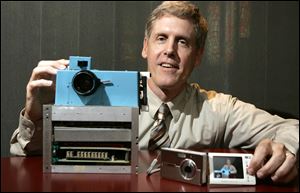
Kodak opts to shutter digital camera sales
2/10/2012
Steven J. Sasson, then-project manager for Eastman Kodak Co., shows the prototype digital camera he built in 1975, left, and Kodak's EasyShare One at the firm's headquarters in 2005. Kodak said Thursday it no longer will make digital cameras or pocket video cameras.
ROCHESTER, N.Y. -- Eastman Kodak Co. said Thursday that it will stop making digital cameras, pocket video cameras, and digital picture frames, marking the end of an era for the firm that brought photography to the masses more than a century ago.
Founded by George Eastman in 1880, Kodak was known all over the world for its Brownie and Instamatic cameras and its yellow-and-red film boxes. But Kodak was battered by Japan in the 1980s, and was then unable to keep pace with the shift from film to digital technology.
Kodak, which filed for bankruptcy protection last month, said it will phase out the product lines in the first half of this year and instead look for other companies to license its brand for those products.
It's an especially poignant moment for Kodak. In 1975, using a new type of electronic sensor invented six years earlier at Bell Labs, a Kodak engineer named Steven Sasson created the first digital camera. It was a toaster-size prototype capturing black-and-white images at a resolution of 0.1 megapixels.
Through the 1990s, Kodak spent some $4 billion developing the photo technology inside most of today's cell phones and digital devices. But a reluctance to ease its heavy financial reliance on film allowed rivals like Canon Inc. and Sony Corp. to rush into the fast-emerging digital arena.
Today, the standalone digital camera faces stiff competition, as smartphone cameras gain broader use. Kodak owns patents that cover a number of basic functions in many smartphone cameras. The company picked up $27 million in patent-licensing fees in the first half of 2011. It made about $1.9 billion from those fees in the previous three years combined.
Kodak sees home photo printers, high-speed commercial inkjet presses, workflow software, and packaging as the core of its future business. Since 2005, the company has poured hundreds of millions of dollars into new lines of inkjet printers. Once the digital camera business is phased out, Kodak said its consumer business will focus on printing. It will continue to honor product warranties and provide technical support for the discontinued products.